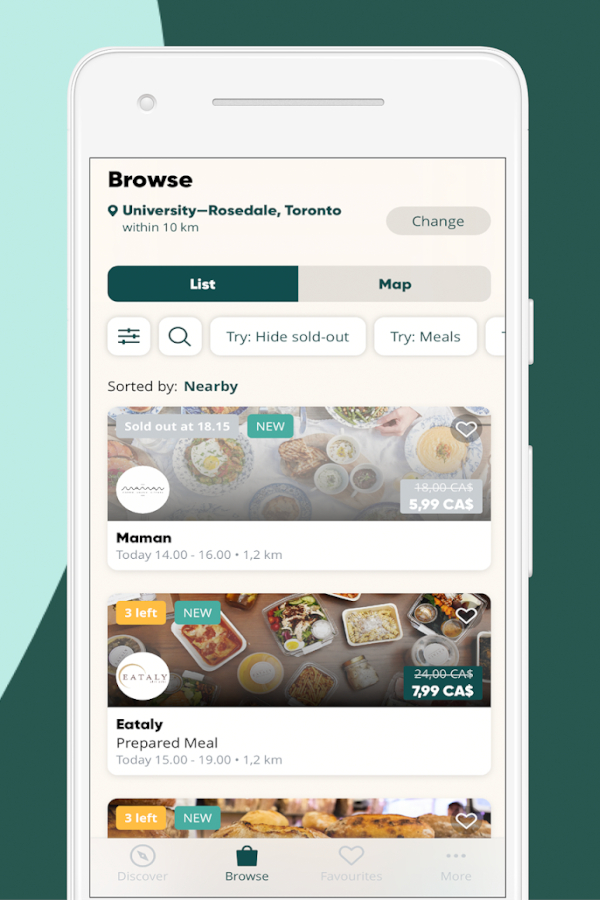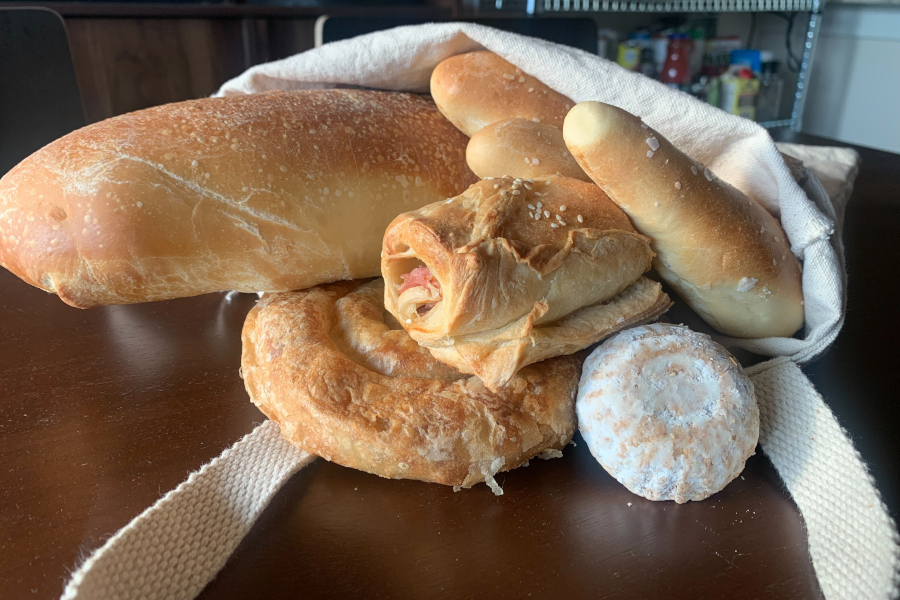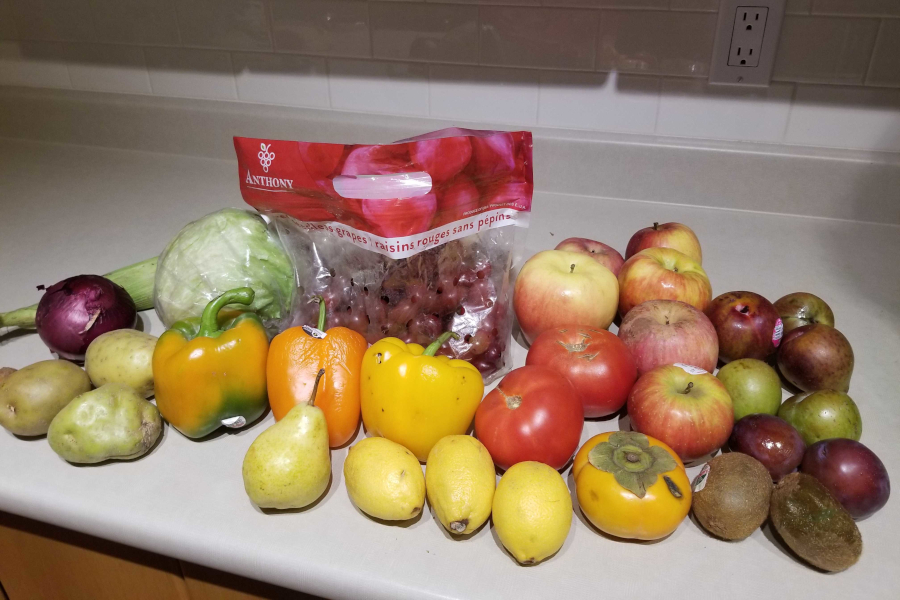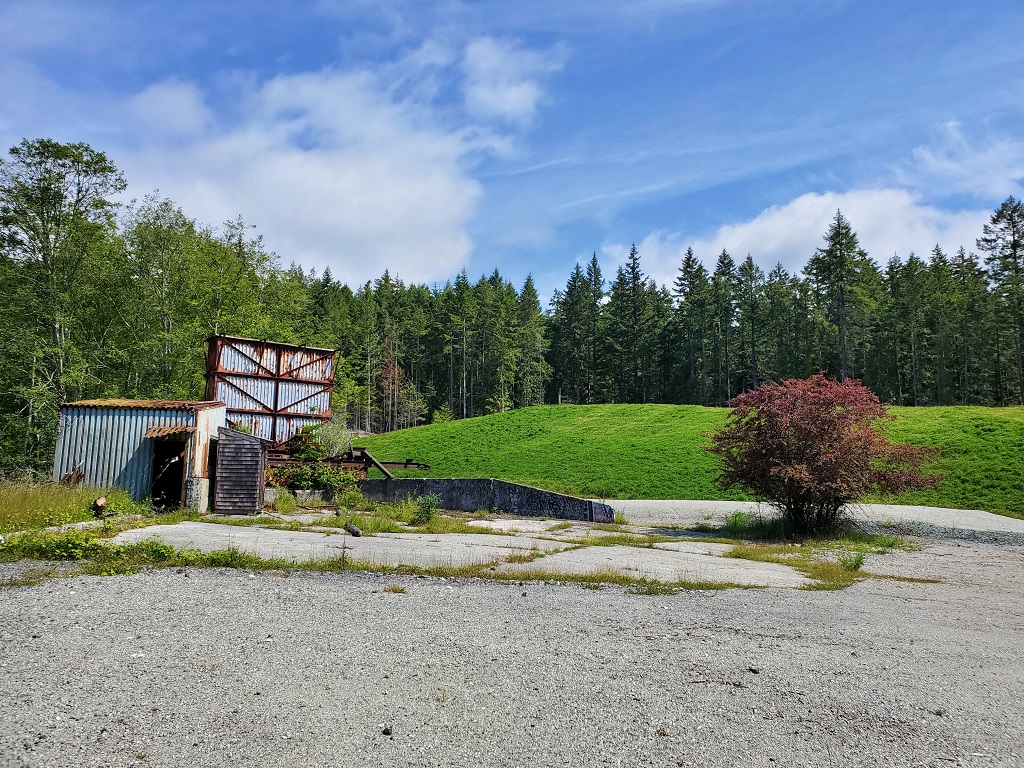Too Good To Go
Have you wondered what it’s like to use a food app and get a surprise bag? I did, so I asked one of my friends about their experience with Too Good To Go – the world’s most popular food rescue app – and I decided to try it myself here in Vancouver.

The Too Good To Go app (image courtesy of Too Good To Go).
Too Good To Go is a company founded in Copenhagen in 2016 that aims to reduce food waste across the globe. They have expanded to 17 countries, adding Canada in 2021, and their primary operation is a phone app that allows restaurants, cafés, bakeries and grocery stores to sell surplus meals and ingredients to app users, for one third of the regular price, in the form of surprise bags. Vendors choose one of the three price points ($4.99, $5.99 or $7.99) and a pick-up time window for their surplus food. Individuals purchase the bags through the app, without knowing exactly what the bags contain, and then pick them up within the agreed time window.
My Friend’s Experience
I spoke with a friend of mine, who has been using the Too Good to Go App since October 2021, to learn more about the user experience.
Q: What motivates you to use Too Good to Go?
A: I like being able to sample a wide variety of food at heavily discounted prices. I like to try new restaurants. I notice when new restaurants open and I make lists of places I want to try. The app makes that less expensive.
Q: Do you mainly use it for ingredients or meals?
A: Lately, I’ve been buying ingredients. But that’s changed over time.
Q: How many Surprise Bags do you typically buy in a week and how much does that cost?
A: Now, I usually buy one bag a week, on the weekend, and that lasts me an entire week. It costs $4.99.
In the beginning, it felt like Pokemon Go. I wanted to catch ‘em all by trying all the restaurants. I was also trying to figure out how it works, understanding the terms and conditions, and trying to learn what time bags would usually be released. At that point, I was getting around 3 bags per week. That would be about $15-30.
After a while, I started reserving several bags every weekend and I’d basically spend one or two days just trying to get as much as I could. It got pretty expensive. Eventually, I got to a point where I was satisfied with the amount of restaurants I was able to try. Now, I find it much more economical to just buy one bag of ingredients a week, from the same place. Before, I was getting lots of bread and pastries. Then, I found Planted Meals, which is a meal prep service. They put vegetables, grains and plant protein in their bags. I usually get my weekly bag from them now.

Surprise Bag from Rustic Bread Bakery purchased for $5.99 on Friday October 7th, 2022.
Q: What do you think of the food quality?
A: I’m not picky. I don’t remember any issues. Once, I did get a cinnamon bun that was a bit hard and dry.
Q: What were some of the best experiences you’ve had with the app?
A: I like the convenience and price of the prepped food I now get from Planted Meals. Earlier on, there was a restaurant I really wanted to try called Chickpea. So, I was excited to get a surprise bag from them. But they aren’t on the app anymore now. I don’t know the reason.
A: What were the worst experiences you’ve had?
There were a few times when I would reserve a bag for pick up the next day, but when I got there, the place was closed for a stat holiday. I assume that the bag was automatically released and the merchant forgot to cancel the release. Also, sometimes I’ve arrived to pick up a bag but there is nothing to be picked up, because they’ve sold everything already and they didn’t cancel my order. It’s good that they don’t have any food waste, but it was a long trip for nothing.
Q: Have you ever bought anything that you ended up tossing instead of eating?
A: Once, I had to throw out some spinach that wasn’t good anymore. They apologized about it when they gave it to me. I managed to salvage some of it.
Q: It seems to me like the unpredictability of Surprise Bags makes it difficult to plan meals. Ideally, I like to make just one grocery store visit a week, do you think I could still do that if I incorporate Surprise Bags into the mix?
A: It depends. It varies a lot how much is in each bag. Everyone’s experience is different. I’ve only tried restaurants, cafes, bakeries and meal prep services, not grocery stores. Because, with grocery stores, it’s such a wide range of possible ingredients. I’d probably have to buy more things to make it work. But I might try it at some point.
It’s useful to see what other people’s bags contain. I compare with other people who are also picking up bags, and I search social media to see what other bags contain. I also ask the staff when I pick up, “What do you usually put in the bags?” There are some places that regularly have certain products on certain days, based on their production schedule.
Q: Do you have any tips for someone new to the app like me?
A: Be open minded and flexible. Know that it’s food that would otherwise be thrown away and you’re getting it at a heavily discounted price. If you’re trying to reserve a bag for pick up on the next day, check for available bags at the end of today’s pick-up window. That’s when bags for the next day are usually released. There’s a rating system. Pick places that have a decent rating. More than 4 stars should be fine.
My Experience
I decided to give the app a try. On a Tuesday morning, I reserved a $4.99 surprise bag from a small grocery store, rated 4.2 stars, for pick up between 6:00pm-7:30pm. When I arrived at Polo Farmer’s Market, the cashier directed me to another staff member at the back of the store. He asked me whether I had brought my own bag, then, using my reusable shopping bag, he gathered up various items from the produce section.

A Surprise Bag from Polo Farmer Market purchased for $4.99 on Tuesday October 11th, 2022.
When I emptied out the bag at home, I was pleasantly surprised by the amount and variety of food. They included potatoes, ginger, onion, lemons, grapes, tomatoes, peppers, kiwis, lettuce, apples, pear, corn, persimmon and plums. As expected, they were imperfect in that there were some scuff marks, some things were starting to go soft, and the lettuce had to be eaten that night as it was going brown. But everything was definitely edible and it does feel meaningful to reduce a bit of food waste.
The app actively reinforces this feeling of having done something good. They sent a notification congratulating me on becoming a “waste warrior” and told me that this surprise bag purchase has saved 3 kg of CO2 emissions. This number is given without any having to input the contents, weight or volume of the bag, but I understand they’ve used average parameters.
Food Waste & Apps
How much food do you think you waste at your house? We all know we shouldn’t do it, but the data shows it’s still happening. In 2019, the Food and Agriculture Organization (FAO) reported that 14% of the food produced for consumption globally each year is lost between harvest and the wholesale market. Downstream of that, the Food Waste Index Report 2021, published by the United Nations Environment Programme (UNEP), estimates that, in 2019, households, food services and retailers discarded 931 million tonnes of food, or 17% of the total food available. The majority was by households, wasting 11%, while food services and retail outlets waste 5% and 2% respectively.
Worldwide, Too Good To Go currently has 172 228 vendors and 65.6 million users, of which 4000 vendors and 500 000 users are in Canada. In addition to the app, Too Good To Go also makes educational material for schools and households, advises public policy, and partners with various food bank charities. In 11 European countries, retailers partnered with Too Good to Go to add labels on their packaged food reminding consumers to “Look, smell, taste –don’t waste” if the food is past the best before date. You can read more about their initiatives here.
Too Good To Go makes the process as simple and transparent as possible. If a person needs to cancel their order, they can do so up to 2 hours before the start of the pick-up window to receive a full refund. A vendor may also cancel surprise bags if they end up selling out of what they thought would have been surplus. Too Good to Go charges a flat fee on every transaction, which is included in the listed price of the surprise bag.
Other companies have also launched similar apps, providing the same service of allowing app users to purchase surplus food from retailers, but without the element of surprise. Flashfood, launched in 2017, was founded in Toronto, Canada. It allows users to buy food nearing its best before date from major retailers such as Superstore and No Frills. Foodhero was founded in Milan, Italy in 2015 and partners with IGA stores in Quebec and New Brunswick to sell food nearing their best before dates.
The Bottom Line
If these kinds of apps sound interesting to you, I encourage you to give one a try. There have always been opportunities to buy imperfect produce, day old bread, and items reduced to sell nearing their best before dates, but hopefully these new apps are reaching more people and adding more incentive. At the end of the day, these apps are making surplus food more attractive.
My experience was positive, and you can read more about all the apps through their reviews and social media platforms:
